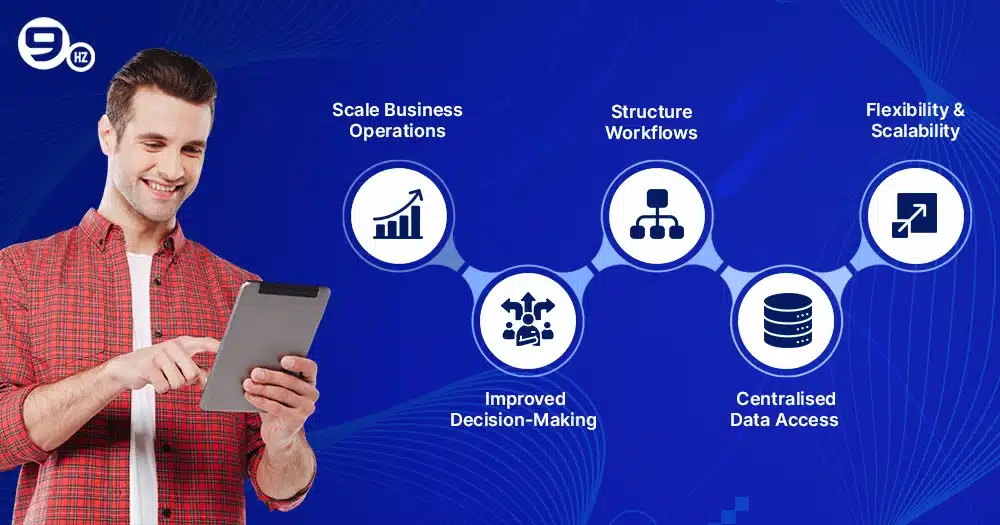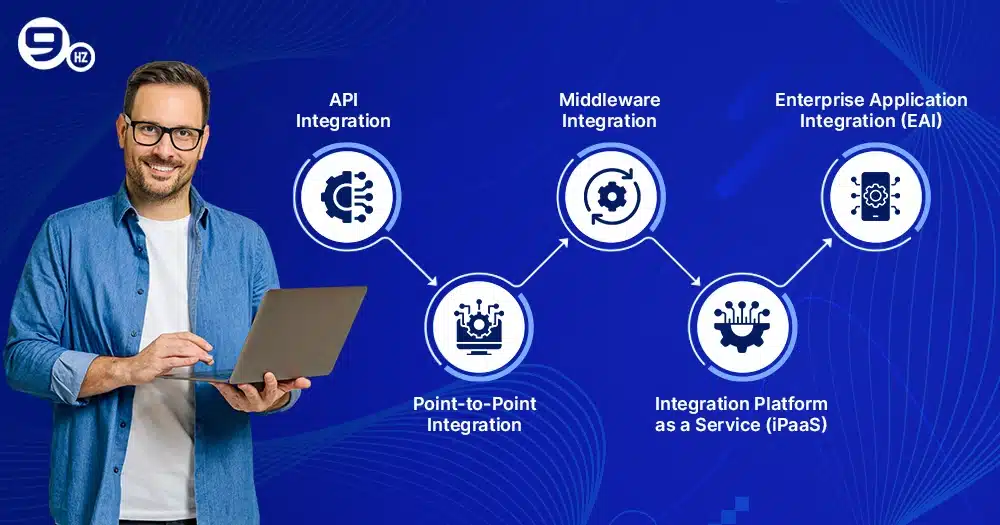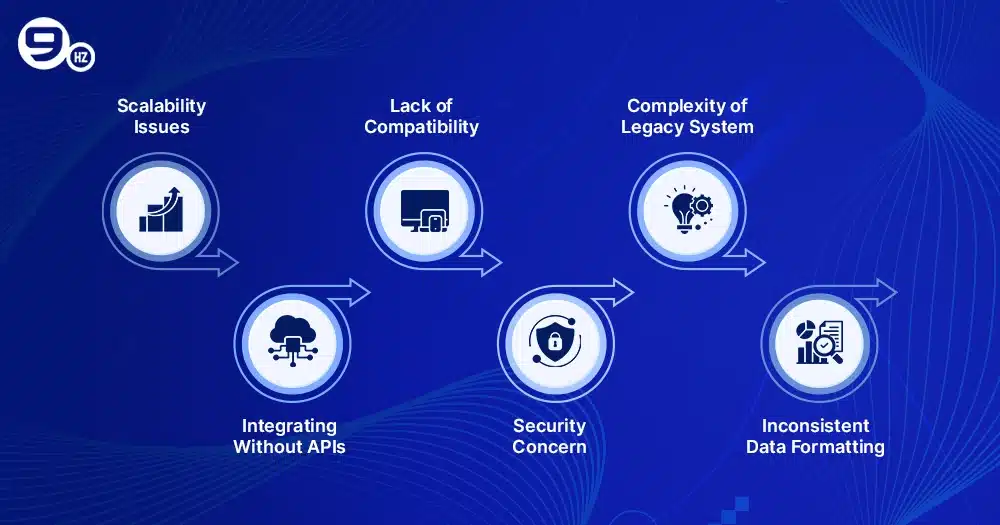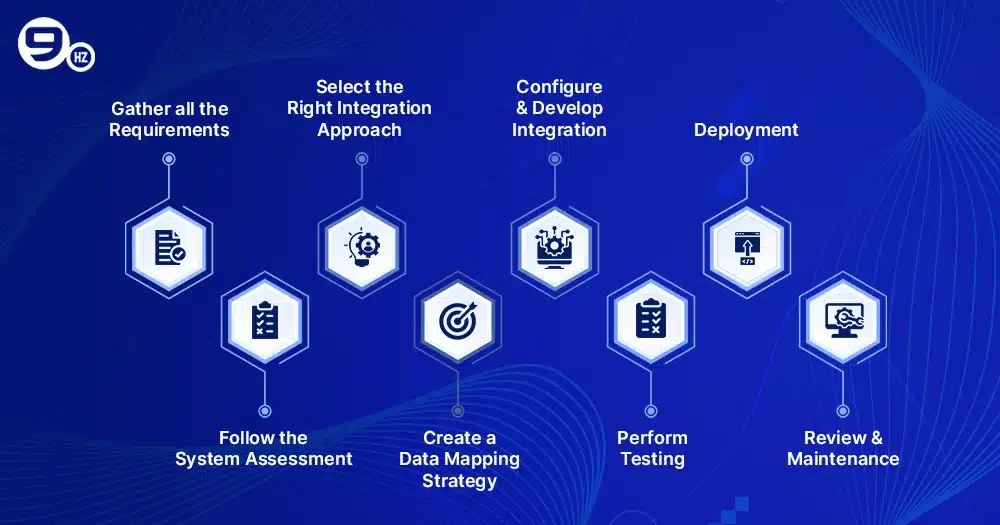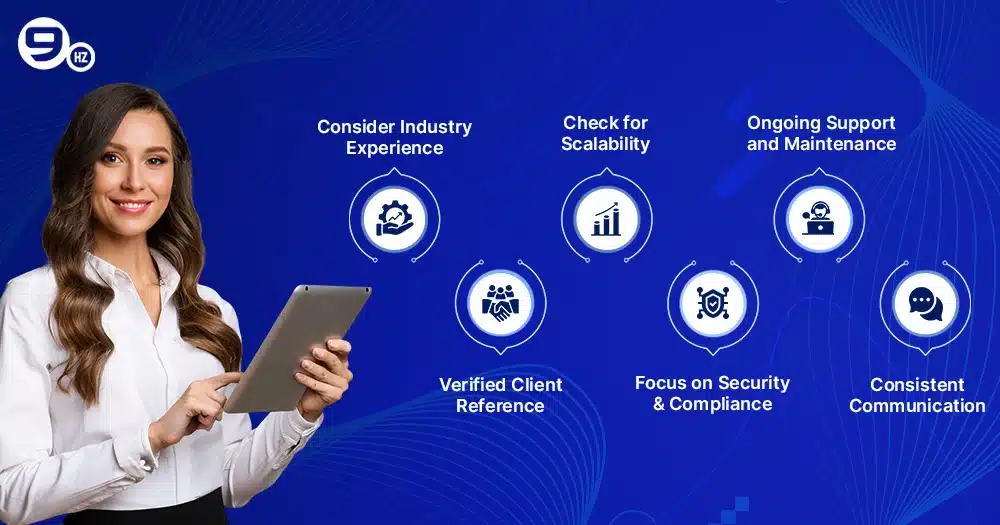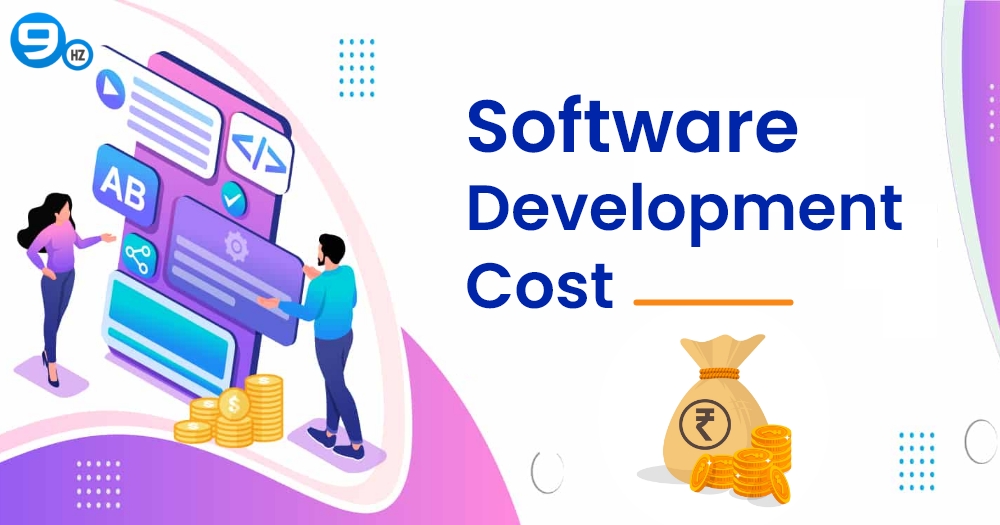The digital landscape opens new doors to business opportunities, managing different departments of operations, sales, HR, and finance – all at once. Without software integration like ERP, marketing automation tools, or CRM software, it would be chaotic to handle the business on a large scale. Too much manual intervention and the risk of human error lead to a lack of operational efficiencies and data workflows. 52% of organisations can expand into new markets through software integration. Connecting to different software and its subsystems helps businesses to improve workflows, dynamic solutions, data processing, and elimination.
Do you want to get detailed information on software integration services? This blog will help you understand the importance of integrating software and its benefits.
What Is Software Integration?
Software Integration is the technique followed for connecting software to the existing business system based on the function required. It shifts business models towards automation, reducing manual tasks and errors and saving more time. Software integration is done through APIs (Application Programming Interface). Once connected, it can transfer real-time data with different platforms, such as ERP, CRM, HR tools, and marketing platforms.
You will find specialised software designed for different functions, such as Shopify or WooCommerce for eCommerce, accounting software like QuickBooks, CRM software like HubSpot or Salesforce, and email marketing tools like Mailchimp. Software integration is not an option. It is necessary to structure the operation, provide quality data, improve efficiencies, and deliver the best customer experience.
Why Is Software Integration Important?
One of the best advantages of software integration for business is saving time and resources. As the demand is rising, software developers are focusing on different development approaches, like DevOps, Waterfall, or Agile, to deploy the best fit in the industry. Here are the following reasons why it is important:
Scale Business Operations
As business expands, it is difficult to manage through a manual process; with software integration, this becomes easier to handle, with scalability through automated tasks and reducing operational complexities.
Improved Decision-Making
Integrating software solutions helps to gather real-time data that supports quick decision-making. The use of dashboards or analytics tools enhances data visibility, implements automation for data flow, and increases productivity.
Structure Workflows
Connecting software for finance, HR, ERP, and CRM can integrate a reliable system for end-to-end workflows. It creates faster responses and details for prompt check-ins for inventory, accounting, and billing.
Centralised Data Access
Software system integration helps avoid data silos and miscommunication while allowing teams to access crucial data across departments. Whether it is sales, finance, customer support, or management, it shares updated data and information.
Flexibility and Scalability
Software integration is done through standard APIs that make it easier to add-ons and scale faster. With increasing data volume, users, and transactions, software systems can integrate new features and replace tools without any risk to entire workflows.
Common Types of Software Integrations
Every business requires software integration, but they might follow a different approach that aligns with specific needs. The company requires software for customer data, finance, supply chain, or marketing. Missing out on using the right type of software integration can lead to resource wastage and technical debt. Here are the types of software integrations:
API Integration
One of the types of Software integration that interconnects different applications using APIs. It enables fast, flexible, and standard integration with systems without manual interventions to establish real-time communication.
Point-to-Point Integration
It creates a direct one-to-one connection between individual software that can perform well with varied interfaces. However, it has a drawback that, as requirements change, its tangled connection web makes it harder to scale.
Middleware Integration
In this method of software integration, a middle and central integration layer connects software to different systems to allow communication. This helps to provide pre-built functionalities for data transformation and routing across departments.
Take a look..
How Much Does Software Development Cost in 2025?
Integration Platform as a Service (iPaaS)
iPaaS tools help with software integration using a cloud-based platform to make it accessible for a non-technical team without any extensive coding. Also, cloud software providers take care of their maintenance and feature checks.
Enterprise Application Integration (EAI)
This is the type of software integration for enterprise-wide systems, including legacy, CRM, and ERP, following through data models, standard interface, and centralised governance. This method breaks down all data silos and ensures every department will access consistent information.
Top Software Integration Challenges
In the digital age, where every other function requires software integration, it is difficult to choose the best considering factors, including types of software, diverse features, and compatibility issues. Poor software system integration can lead to the risk of errors and reduced productivity. Here are the core challenges related to software integration solutions:
Scalability Issues
As the business scales, there is a comparative rise in data volume and user load capacity. Poor integration might create a roadblock for scalability, following performance degradation, bottlenecks, and resource wastage.
Integrating Without APIs
If software integration doesn’t follow through with open and documented APIs, it creates challenges for connecting with the system. Misalignment with software integration leads to integration without reverse engineering, custom code, or middleware.
Lack of Compatibility
Incompatibility can pose a challenge for software applications or systems that can increase data silos and operational inefficiencies. If not aligned properly, integration may create the risk for data mismatch, redundancies, and loss of data.
Security Concern
While integrating software, security, and vulnerabilities can lead to the loss of sensitive data. Businesses aim to maintain software data integrity and confidentiality.
Complexity of Legacy System
Some organisations function according to their specific legacy system, which creates issues when integrating with modern software and makes it more complex. As with traditional systems, there is a risk of flexibility and interoperability.
Inconsistent Data Formatting
Best software integration follows consistent data formatting, and to connect software with the system, clean data must be captured. Otherwise, it creates a challenge of mismatch and missing information.
How to Successfully Integrate Software?
Integrating software using APIs and cloud software seems like an easy task, right? No, this process creates a link between your existing product and the internal system. It is essential to assess requirements and understand how it can deliver the right outcome.
Here are the general steps to be followed for successful software integration solutions:
Step 1: Gather all the Requirements
Firstly, you should document the detailed requirements for why your business requires software integration. Then, gather more information on the right software to choose, its features, subsystems, compatibility factors, and technology.
Step 2: Follow the System Assessment
For the best software integration and smooth deliveries, it is essential to audit the system to check APIs, protocols, limitations, and data formats. This will help you address integration points and potential conflicts beforehand.
Step 3: Select the Right Integration Approach
You can choose from multiple software integration approaches, including point-to-point, middleware, and custom APIs. Based on your business needs and technology compatibility, you should find the one that fits your expectations.
Step 4: Create a Data Mapping Strategy
To comply with the right data formats, it is crucial to follow data mapping for matching fields from one database to another. This allows data from multiple sources to be combined into one single format for a unified view.
Step 5: Configure and Develop Integration
Once you have the fundamental setup for software integration, it is time to develop secure APIs, a middleware platform, and the right Software Development Kits (SDKs). You can test integration scripts to check for functionality.
Step 6: Perform Testing
Before software integration, you can explore different testing methods to track for data accuracy, performance issues, and edge cases. You can use any of the methods, including integration, unit, or performance testing.
Step 7: Deployment
At this stage, after testing, you can release software integration in phases to ensure more stability, minimise risks, and follow a user feedback loop. It helps you to identify bugs and bottlenecks in the controlled environment.
Step 8: Review and Maintenance
After successful software integration, you should set up logs, alerts, and a dashboard to regularly track for any changes and issues. Regular maintenance can save hours and help to adapt to upgrading easily.
Real-World Case Study
Almost every other industry finds its base for software integration that streamlines their operations, improves user experience, and boosts efficiency. Here are real-world examples based on the best software integration solutions:
Atlassian – Technology Upgrades
We can take the example of Atlassian, which uses software integration for DevOps collaboration with Slack and Jira. This integration helps the product development team track bugs and updates. Following this integration, developers can create new tickets and improve communication between project managers, developers, and testers.
Upwork – Remote Working Settings
To manage a remote project team and easily schedule client interactions, Upwork uses software integration with Google Workspace, Asana, and Zoom. It helps to enhance project transparency, collaboration, and productivity with an automatic schedule for meetings.
Glossier – Customer Relationship
For the target campaign and the building of customer relationships, Glossier uses the integration of MailChimp and Salesforce software to study behaviour patterns. It results in more repeated purchases and enhances brand loyalty with automated marketing efforts. This helps the marketing and sales team track real-time data.
Netflix – Content Management
Being at the top of the media industry, Netflix integrated the Workday HRM solution software with Salesforce to align core data for partnering with sales and content production. It unified data for the internal team to enhance workflow efficiency between the departments of business development, content, and Human Resources.
Tips for Choosing the Right Integration Partner
Having clear and defined objectives for software integration will help to find the right partner to develop the best-fit software. In the competitive landscape of tech innovation, it is hard to find an experienced team that can assess your tech needs. So, here are the following tips to select the right software integration partner:
Consider Industry Experience
Industry-based experience should be an unavoidable factor when choosing a software integration partner. They must have a business domain understanding and versatile tech expertise in Microsoft, SAP, Salesforce, or Custom APIs.
Verified Client Reference
Reach out to the company with a list of verified clients who have positive feedback on services, communication, and reliability. Explore the website, third-party rating sites, and client testimonials, or, if possible, directly ask for suggestions.
Check for Scalability
Software integration should not be one-size-fits-all; this is subject to changes based on technology, features, and business needs. So, your software integration provider should allow scalability and ease any new updates.
Focus on Security and Compliance
Trusting another partner for software integration means sharing confidential data, which can be risky. To develop secure software, adhere to data security, compliance measures, audit trails, and encryption.
Ongoing Support and Maintenance
Software deployment is not a one-time job. It requires constant support, monitoring, review, testing, and maintenance. Find a partner with the best support services to maintain long-term success in software integration.
Consistent Communication
The key measure to track for a software integration project is communication. You can check on how they collaborate with clients through transparent communication, regular updates, and a better approach to staying updated on integration.
Why Choose Ninehertz for your software Integration?
If you are looking for the best partner for your software integration solution, NineHertz should be the top choice. It is one of the best software development companies with a high rating, proven 15+ years of industry experience, and tech expertise in delivering software development and integrations. Here, experts will give you a free estimate on the project, perform requirement analysis, and deploy software integration with less disruption to your existing business operation.
NineHertz has worked with 1,000+ clients and has industry-specific portfolios ranging from healthcare, finance, retail, and edtech. We provide an excellent tech stack for integration platforms, API gateways, programming languages, messaging, database, ETL tools, cloud services, and DevOps tools. Whether you are looking for a software integration solution for workflow automation or to upgrade your performance and scalability, NineHertz, as leading software development company can manage your requirements to deliver a future-ready product.
Conclusion
By the end of the blog, software integration helps businesses grow in the digital space and allows interconnected systems to function without any disruptions. Businesses can set a high benchmark with careful assessment, finding the right tools, checking for data consistency, and implementing security measures to deploy the best software integration. As this decision involves time and resource allocation, it is essential to follow steps to gather requirements, design for integration, testing, deployment, and ongoing maintenance. Emerging tech trends are also making it easier to navigate for software system integration, such as AI, ML, EDA, API-first development, or blockchain.
Frequently Asked Questions
What is software integration?
It refers to the process of integrating several software components into a unified system or connecting software to existing business systems.
Why is software integration important for businesses?
Software integration establishes structured data flow, optimises for automation work processes, reduces cost, and boosts overall business efficiency.
What are the common types of software integrations?
Some of the types of integration are API, data, third-party, cloud, middleware, and Enterprise Application integrations.
What challenges can occur during software integration?
A few challenges for software integration are data incompatibility, lack of standard APIs, security risk, scalability issues, and system complexities.
How does API integration work?
It works to connect two different applications or software. One system sends a request using the API while another processes it and sends back data to perform the required action.
What tools are used for software integration?
Some of the key tools for software integration are Dell Boomi, Jitterbit, Mulesoft, Talend, Pentaho, SnapLogic, Fivetran, Selenium, and Workato.
How long does software integration take?
It can range between 2 or 3 weeks and more than 3 months, depending on multiple factors, such as project complexity, data volume, customisation, and feature integration.
Is software integration expensive?
The cost will be affordable for simple software integration, while it can be expensive for complex and large-scale projects.
Great Together!

